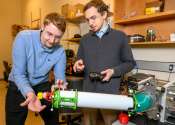'Electronic skin' promises cheap and recyclable alternative to wearable devices
Researchers at the University of Colorado Boulder are developing a wearable electronic device that's "really wearable"—a stretchy and fully-recyclable circuit board that's inspired by, and sticks onto, human skin.
Nov 6, 2020
1
248









